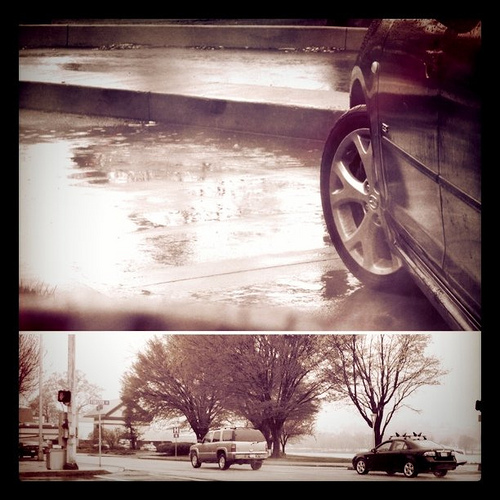Eye-Fi Pro X2 now with Direct Mode
 Tuesday, April 19, 2011 at 9:31PM
Tuesday, April 19, 2011 at 9:31PM  Rainy Day Diptic: Shot with LX-5, Direct Transfered to iPhone to process in DipTic and Instagram and share on various social networks.
Rainy Day Diptic: Shot with LX-5, Direct Transfered to iPhone to process in DipTic and Instagram and share on various social networks.I've been shooting with an EyeFi ProX2 card the past few weeks in my LX5 and I've been impatiently waiting for the latest revision to the firmware. Why? Because EyeFi added a direct mode feature that lets you connect your camera to a SmartPhone (iPhone/android), iPad or PC without needing to be connected to a WiFi network. This means you can be shooting "on location" and you can port those files from your regular camera (that accepts SD) direct to your portable devices.
I've loved sharing photos via Instagram on twitter and facebook. My biggest problem is that I have an iPhone 3G and the camera lacks a LOT of feature that I rely on, like aperture or shutter control, flash, off-camera hot-shoe, better resolution and focus (the list goes on). Now I'm able to use my LX-5 and process with my iPhone and share with my social network anywhere, anytime. It's pretty cool.
My initial feelings with the EyeFi card was mixed. I have a buggy WiFi connection at home. I'm not sure if it's interference from neighbors or my router or the radio towers on the hill I live on, but I frequently get dropped connections with all my WiFi devices. This instantly lets me be less then impressed with most WiFi tech.
I'm going to chock up a lot of my initial setup hiccups with the EyeFi card to this connection issue I have. I also started out trying to use my EyeFi card with my netbook as an AdHoc network that I could sync try to use ShutterSnitch to suck images from my card to my iPhone using this, but it was a hassle. So I was a little frustrated using an EyeFi card at first. Then again, using it this way isn't exactly standard procedure (although the ProX2 does support AdHoc networking... I found it a hassle and I didn't have the patience to sort it out. Especially since I knew that direct mode was right around the corner and that was REALLY what I wanted to use anyway.)
The EyeFi iOS apps are still currently awaiting approval to be able to use the Direct Mode function, but the app ShutterSnitch is one that currently supports it. I could write an entire review on this app. It looks great on the iPad... iPhone... well, not so much. But I blame that on the size of the interface and I'm assuming it was developed as an iPad app primarily. But it does do the job.
I have selective transfer mode turned on for my EyeFi card so when I want to send a photo to my iPhone, I "protect" the phone I want transferred and this activates the WiFi on the card (battery savings? I don't know...) then select that network on the iPhone and boot up ShutterSnitch and it goes and grabs the files and brings them in. Currently, it's grabbing RAW and JPEG because I'm shooting RAW+JPEG, but I'm trying to resolve that issue. I have the ShutterSnitch settings to "accept JPEGS only" but I'm guessing that the selective transfer is forcing both file types. I just delete the RAW file when it gets to my phone.
Two other key issues that I have. As I said, I have an iPhone 3G running iOS 4 so it's a little sluggish to begin with. And all my apps, crash with a 9mp JPEG photo. So, I had switched my camera to shooting in 4:3 ratio at 2mp files (I believe this is only the JPEG, but need to confirm that. I believe that the RAW is RAW.) I have also found a setting for ShutterSnitch that saves a "small" version of the photo in your photo ablumn when I export it from ShutterSnitch to be able to use it in another iPhone Photo App. I plan to do more testing with these features to see how small a file it is and what's the best option for using more of the more robust features of ShutterSnitch aside from just using it for Direct Mode Transfer
FTC Disclosure: EyeFi card provided as a demo unit. There we no terms to using this demo, only to use it and share my experiences with it. ShutterSnitch and other iPhone apps mentioned in this blog post were personally purchased from the iPhone store and were not provided.
 LX-5,
LX-5,  Social,
Social,  eye-fi,
eye-fi,  mobile,
mobile,  technology in
technology in  Photography,
Photography,  Review,
Review,  Sharing
Sharing 



